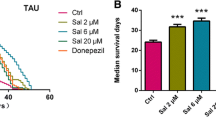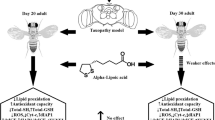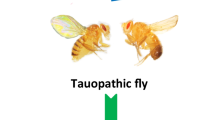Abstract
This study evaluated the effect of gallic acid on some selected biomarkers in Drosophila melanogaster model of Alzheimer’s disease (AD). Transgenic D. melanogaster expressing human amyloid precursor protein and β-secretase (BACE 1) genes were used as AD flies while wild type (Oregon strain) flies served as the normal control flies. Both fly strains were exposed to gallic acid in their diet. Thereafter, the flies were sacrificed and homogenized. The homogenates were assayed for reactive oxygen species (ROS), malondialdehyde (MDA) and total thiol contents, as well as the activity of catalase. Also the activity of cholinesterases (ChEs) and β-secretase (BACE-1) were quantified. Results showed that the AD flies had significantly higher ChEs and BACE-1 activity, ROS and MDA contents, as well as lower total thiol level and catalase activity compared to the normal control flies. However, these biochemical impairments in AD control flies were significantly ameliorated in AD flies treated with gallic acid. Therefore, this study has shown that gallic acid could ameliorate elevated ChEs and BACE-1 activities, as well as oxidative stress induced by β-amyloid generation in D. melanogaster model of AD. This therefore, suggests gallic acid as a promising nutraceutical for the management of AD.








Similar content being viewed by others
Abbreviations
- AChE:
-
Acetylcholinesterase
- BChE:
-
Butyryllcholinesterase
- AD:
-
Alzheimer’s disease
- APP:
-
Amyloid precursor protein
- BACE-1:
-
β-Secretase
- DCF:
-
2′,7′-Dichloroflourescein
- DEPPD:
-
N,N-Diethyl-para-phenylenediamine
- DL-BAPNA:
-
N-α-Benzoyl-d,l-arginine p-nitroanilide
- DMSO:
-
Dimethyl sulfoxide
- RONS:
-
Reactive oxygen/nitrogen species
References
Abe I, Seki T, Noguchi H (2000) Potent and selective inhibition of squaleneepoxidase by synthetic gallic esters. Biochem Biophys Res Commun 270:137–140
Abolaji OA, Kamdem JP, Lugokenski TH, Nascimento TK, Waczuk EP, Farombi EO, Loreto EL, Rocha JBT (2014) Involvement of oxidative stress in 4-vinylcyclohexene-induced toxicity in Drosophila melanogaster. Free Radic Biol Med 71:99–108
Abolaji AO, Olaiya CO, Oluwadahunsi JO, Farombi EO (2017) Dietary consumption of monosodium l-glutamate induces adaptive response and reduction in the life span of Drosophila melanogaster. Cell Biochem Funct. https://doi.org/10.1002/cbf.3259
Abuajah CI, Ogbonna AC, Osuji CM (2015) Functional components and medicinal properties of food: a review. J Food Sci Technol 52(5):2522–2529
Adedara IA, Abolaji AO, Rocha JBT, Farombi EO (2016) Diphenyl diselenide protects against mortality, locomotor deficits and oxidative stress in Drosophila melanogastermodel of manganese-induced neurotoxicity. Neurochem Res. https://doi.org/10.1007/s11064-016-1852-x
Adefegha SA (2018) Functional foods and nutraceuticals as dietary intervention in chronic diseases; novel perspectives for health promotion and disease prevention. J Diet Suppl 15(6):977–1009
Akinrinde AS, Adebiyi OE (2019) Neuroprotection by Luteolin and Gallic acid against cobalt chloride-induced behavioural, morphological and neurochemical alterations in Wistar rats. Neurotoxicology 74:252–263
Ban JY, Nguyen HTT, Lee HJ, Cho SO, Ju HS, Kim JY et al (2008) Neuroprotective properties of gallic acid from Sanguisorbae radix on amyloid β protein (25–35)-induced toxicity in cultured rat cortical neurons. Biol Pharmaceut Bull 31(1):149–153
Bradford MM (1976) A rapid and sensitive method for the quantitation of microgram quantities of protein utilizing the principle of protein-dye binding. Anal Biochem 72:248–254
Brand-Williams W, Cuvelier ME, Berset C (1995) Use of a free radical method to evaluate antioxidant activity. LWT-Food Sci Technol 28:25–30
Chakraborty R, Vepuri V, Mhatre SD, Paddock BE, Miller S, Michelson SJ, Utreja S et al (2011) Characterization of a Drosophila Alzheimer’s disease model: pharmacological rescue of cognitive defects. PLoS ONE 6(6):e20799
Chanda S, Dave R (2009) In vitro models for antioxidant activity evaluation and some medicinal plants possessing antioxidant properties: an overview. Afr J Microb Res 3(13):981–996
Citron M (2004) β-Secretase inhibition for the treatment of Alzheimer’s disease–promise and challenge. Trends Pharmacol Sci 25(2):92–97
Denise G, Lucas SM, Juliana V, Clóvis P, Gabriela S, Solange CG (2009) Importance of the lipid peroxidation biomarkers and methodological aspects for malondialdehyde quantification. Quim Nova 32(1):169–174
Dwibedy P, Dey GR, Naik DB, Kishore K, Moorthy PN (1999) Pulseradiolysis studies on redox reaction of gallic acid: one electron oxidation of gallic acid by hallic acid OH adduct. Phys Chem 1:1915–1918
Ellman GL (1959) Tissue sulfhydryl groups. Arch Biochem Biophys 82:70–77
Gillham B, Papachristodoulou DK, Thomas JH (1997) Will’s: biochemical basis of medicine, 3rd edn. Butterworth-Heinemann, Oxford, p 1997
Gotz J, Chen F, Barmettler R, Nitsch RM (2001) Tau filament formation in transgenic mice expressing P301L tau. J Biol Chem 276:529–534
Gramza A, Korczak J, Amarowicz R (2005) Tea polyphenols—their antioxidant properties and biological activity—a review. Pol J Food Nutr Sci 14/55:219–235
Gul K, Singh AK, Jabeen R (2016) Nutraceuticals and functional foods: the foods for the future world. Crit Rev Food Sci Nutr 56(16):2617–2627
Hanninen O, Alessio HM, Packer L, Sen CK (eds) (2000) Handbook of oxidants and antioxidants in exercise. Elsevier, Amsterdam
Hayashi I, Morishita Y, Imai K, Nakamura M, Nakachi K, Hayashi T (2007) High through put spectrophotometric assay of reactive oxygen species in serum. Mutat Res 631:5561
Heemels MT (2016) Neurodegenerative diseases. Nature 539:179
Hsiao K, Chapman P, Nilsen S, Eckman C, Harigaya Y, Younkin S, Yang F, Cole G (1996) Correlative memory deficits, A beta elevation, and amyloid plaques in transgenic mice. Science 274:99–102
Hu W, Gray NW, Brimijoin S (2003) Amyloid-beta increases acetylcholinesterase expression in neuroblastoma cells by reducing enzyme degradation. J Neurochem 86(2):470–478
Iijima-Ando K, Iijima K (2010) Transgenric Dosophila models of Alzheimer’s disease and tauopathies. Brain Struct Funct 214(2–3):245–262
Jayamani J, Shanmugam G (2014) Gallic acid, one of the components in many plant tissues, is a potential inhibitor for insulin amyloid fibril formation. Eur J Med Chem 85:352–358
Karamaæ M, Kosiñska A, Pegg RB (2005) Comparison of radical-scavenging activities of selected phenolic acids. Pol J Food Nutr Sci 14(55):165–170
Katja P, Aaron V, Jörg BS (2013) Drosophila melanogaster as a model organism for Alzheimer’s disease. Mol Neurodegener 8:35
Kim MJ, Seong AR, Yoo JY, Jin CH, Lee YH, Kim YJ et al (2011) Gallic acid, a histone acetyltransferase inhibitor, suppresses β-amyloid neurotoxicity by inhibiting microglial-mediated neuroinflammation. Mol Nutr Food Res 55(12):1798–1808
Lin MT, Beal MF (2006) Mitochondrial dysfunction and oxidative stress in neurodegenerative diseases. Nature 443:787–795
Liu Y, Pukala TL, Musgrave IF, Williams DM, Dehle FC, Carver JA (2013) Gallic acid is the major component of grape seed extract that inhibits amyloid fibril formation. Bioorg Med Chem Lett 23(23):6336–6340
Locatelli C, Filippin MFB, Creczynski PTB (2013) Alkyl esters of gallic acid as anticancer agents: a review. Eur J Med Chem 60:233–239
Luo L, Tully T, White K (1992) Human amyloid precursor protein ameliorates behavioral deficit of flies deleted for Appl gene. Neuron 9:595–605
Mancini F, Naldi M, Cavrini V, Andrisano V (2007) Multiwellfluorometric and colorimetric microassays for the evaluation of beta-secretase (BACE-1) inhibitors. Anal Bioanal Chem 388(5–6):1175–1183
Marchasson IB, Beauvieux MCD, Peuchant E, Harston SR, Decamps A, Reignier B, Emeriau JP, Rainfray M (2001) Antioxidant defences and oxidative stress markers in erythrocytes and plasma from normally nourished elderly Alzheimer patients. Age Ageing 30:235
Maya S, Prakash T, Goli D (2018) Evaluation of neuroprotective effects of wedelolactone and gallic acid on aluminium-induced neurodegeneration: relevance to sporadic amyotrophic lateral sclerosis. Eur J Pharmacol 835:41–51
Melo JB, Agostinho P, Oliveira CR (2003) Involvement of oxidative stress in the enhancement of acetylcholinesterase activity induced by amyloid beta-peptide. Neurosci Res 45(1):117–127
Mhatre SD, Satyasi V, Killen M, Paddock BE, Moir RD, Saunders AJ, Marenda DR (2014a) Synaptic abnormalities in a Drosophila model of Alzheimer’s disease. Dis Models Mech 7(3):373–385
Mhatre SD, Michelson SJ, Gomes J, Tabb LP, Saunders AJ, Marenda DR (2014b) Development and characterization of an aged onset model of Alzheimer’s disease in Drosophila melanogaster. Exp Neurol 261:772–781
Mori T, Rezai-Zadeh K, Koyama N, Arendash GW, Yamaguchi H, Kakuda N et al (2012) Tannic acid is a natural β-secretase inhibitor that prevents cognitive impairment and mitigates Alzheimer-like pathology in transgenic mice. J Biol Chem 287(9):6912–6927
Nagpal K, Singh SK, Mishra DN (2013) Nanoparticle mediated brain targeted delivery of gallic acid: in vivo behavioral and biochemical studies for protection against scopolamine-induced amnesia. Drug Delivery 20(3–4):112–119
Oboh G, Ogunsuyi OB, Ojelade MT, Akomolafe SF (2018) Effect of dietary inclusions of bitter kola seed on geotactic behavior and oxidative stress markers in Drosophila melanogaster. Food Sci Nutr 6(8):2177–2187
Ohakawa H, Ohishi N, Yagi K (1979) Assay of lipid peroxidation in animal tissue by thiobarbituric acid reaction. Anal Biochem 95:351–358
Pérez-Severiano F, Santamaría A, Pedraza-Chaverri J, Medina-Campos ON, Ríos C, Segovia J (2004) Increased formation of reactive oxygen species, but no changes in glutathione peroxidase activity, in striata of mice transgenic for the Huntington’s disease mutation. Neurochem Res 29(4):729–733
Rice-Evans CA, Miller NJ, Paganga G (1996) Structure-antioxidant activity relationship of flavonoids and phenolic acids. Free Radic Biol Med 20:933–956
Rose K, Wan C, Thomas A, Seeram NP, Ma H (2018) Phenolic compounds isolated and identified from amla (Phyllanthus emblica) juice powder and their antioxidant and neuroprotective activities. Nat Product Commun 13(10):1309–1311. https://doi.org/10.1177/1934578X1801301019
Saeki K, You A, Isemura M, Abe I, Seki T et al (2000) Apoptosis inducing activity of lipid derivatives of gallic acid. Biol Pharm Bull 23:1391–1394
Sakaguchi N, Inoue M, Ogihara Y (1998) Reactive oxygen species and intracellular Ca2+, common signals for apoptosis induced by gallic acid. Biochem Pharmacol 55:1973–1981
Sayre LM, Smith MA, Perry G (2001) Chemistry and biochemistry of oxidative stress in neurodegenerative disease. Curr Med Chem 8(7):721–738
Sberna G, Sáez-Valero J, Li QX, Czech C, Beyreuther K, Masters CL, McLean CA, Small DH (1998) Acetylcholinesterase is increased in the brains of transgenic mice expressing the C-terminal fragment (CT100) of the β-amyloid protein precursor of Alzheimer’s disease. J Neurochem 71(2):723–731
Serge P, Miquel V, Vernice J (2003) Neurodegeneration: what is it and where are we? J Clin Invest 111:3–10
Shina AK (1972) Colorimetric assay of catalase. Anal Biochem 47:389–394
Squier TC (2001) Oxidative stress and protein aggregation during biological aging. Exp Gerontol 36:1539–1550
Sturchler-Pierrat C, Abramowski D, Duke M, Wiederhold KH, Mistl C, Rothacher S, Ledermann B, Burki K, Frey P, Paganetti PA et al (1997) Two amyloid precursor protein transgenic mouse models with Alzheimer disease-likenpathology. Proc Natl Acad Sci USA 94:13287–13292
Teixeira A, Baenas N, Dominguez-Perles R, Barros A, Rosa E, Moreno DA, Garcia Viguera C (2014) Natural bioactive compounds from winery by products as health promoters: a review. Int J Mol Sci 15:15638–15678
Teschendorf D, Link CD (2009) What have worm models told us about the mechanisms of neuronal dysfunction in human neurodegenerative diseases? Mol Neurodegener 4:38
Uttara B, Singh AV, Zamboni P, Mahajan RT (2009) Oxidative Stress and neurodegenerative diseases: a review of upstream and downstream antioxidant therapeutic options. Curr Neuropharmacol 7:65–74
Vassar R (2004) Bace 1. J Mol Neurosci 23(1–2):105–113
Winderickx J, Delay C, de Vos A, Klinger H, Pellens K, Vanhelmont T, van Leuven F, Zabrocki P (2008) Protein folding diseases and neurodegeneration: lessons learned from yeast. Biochim Biophys Acta 1783:1381–1395
Xie Q, Wang H, Xia Z, Lu M, Zhang W, Wang X, Fu W, Tang Y, Sheng W, Li W, Zhou W (2008) Bis-(−)-nor-meptazinols as novel nanomolar cholinesterase inhibitors with high inhibitory potency on amyloid-β aggregation. J Med Chem 51(7):2027–2036
Yadav M, Jindal DK, Dhingra MS, Kumar A, Parle M, Dhingra S (2018) Protective effect of gallic acid in experimental model of ketamine-induced psychosis: possible behaviour, biochemical, neurochemical and cellular alterations. Inflammopharmacology 26(2):413–424
Yan R, Vassar R (2014) Targeting the β secretase BACE1 for Alzheimer’s disease therapy. Lancet Neurol 13(3):319–329
Youn K, Jun M (2012) Inhibitory effects of key compounds isolated from Corni fructus on BACE1 activity. Phytother Res 26(11):1714–1718
Acknowledgements
The authors wish to appreciate Dr. Daniel R. Marenda of the Department of Biology, University of Drexel, Philadelphia, USA for the generous gift of the transgenic Alzheimer’s disease flies used for this study
Author information
Authors and Affiliations
Corresponding author
Ethics declarations
Ethical statement
This article does not contain any studies with human participants or animals performed by any of the authors.
Conflict of interest
Opeyemi B. Ogunsuyi has no conflict of interest. Ganiyu Oboh has no conflict of interest. Odunayo O. Oluokun has no conflict of interest. Adedayo O. Ademiluyi has no conflict of interest. Omodesola O. Ogunruku has no conflict of interest.
Additional information
Publisher's Note
Springer Nature remains neutral with regard to jurisdictional claims in published maps and institutional affiliations.
Rights and permissions
About this article
Cite this article
Ogunsuyi, O.B., Oboh, G., Oluokun, O.O. et al. Gallic acid protects against neurochemical alterations in transgenic Drosophila model of Alzheimer’s disease. ADV TRADIT MED (ADTM) 20, 89–98 (2020). https://doi.org/10.1007/s13596-019-00393-x
Received:
Accepted:
Published:
Issue Date:
DOI: https://doi.org/10.1007/s13596-019-00393-x




